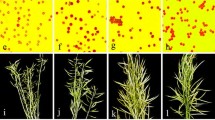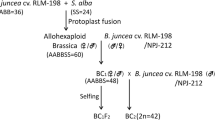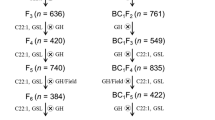Abstract
The frequency of hybridisation between Brassica napus L. and Raphanus raphanistrum L. under agronomic conditions was assessed in field experiments, where R. raphanistrum were randomly planted at two different densities into large plots of B. napus. An acetolacate synthase (ALS)-inhibiting herbicide-resistant trait was used to detect potential hybrid individuals. No hybrids were detected amongst 25,000 seedlings grown from seed collected from R. raphanistrum plants. Two hybrids were obtained from more than 52-million B. napus seedlings. Both hybrids were characterised as amphidiploids (AACCRrRr, 2n = 56) and were fertile. The frequency of hybridisation into B. napus in this experiment using male-fertile B. napus was 4 × 10–8.
Similar content being viewed by others
Author information
Authors and Affiliations
Additional information
Received: 31 August 2000 / Accepted: 23 January 2001
Rights and permissions
About this article
Cite this article
Rieger, M., Potter, T., Preston, C. et al. Hybridisation between Brassica napus L. and Raphanus raphanistrum L. under agronomic field conditions. Theor Appl Genet 103, 555–560 (2001). https://doi.org/10.1007/PL00002909
Issue Date:
DOI: https://doi.org/10.1007/PL00002909




